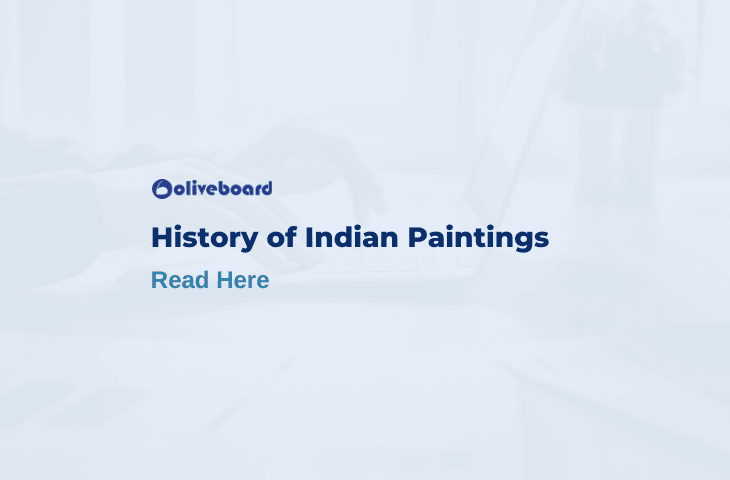Last updated on February 25th, 2021 at 09:50 am
Today government jobs are in demand due to the stature, prestige, and numerous benefits that come along. More and more people these days are opting for Govt. exams with the aim of getting into the banking sector, or other Govt. departments, ministries and organizations. However, to get there, you need to crack the online entrance examination. The exam is conducted in different stages and the syllabus covers ancient as well as contemporary topics. If you are appearing for the SSC CGL exam, then one important section of your paper will be ‘Indian History’. Knowing about the history of Indian culture can help you score good marks in the examination, which is why we have compiled a list that talks about the history of Indian paintings.
History of Indian Paintings
Indian paintings offer an aesthetic continuum, which extends from early civilization to the present day. Initially depicting religious beliefs and values, Indian paintings have now evolved to become a synthesis of diverse traditions and cultures. Here is a list of paintings that have been the epitome of Indian culture and history since decades
1. Murals
The history of Indian Murals dates back to the early medieval and ancient times (2nd Century B.C. to 10th Century A.D.). All over India, over 20 locations boast of mural paintings, which depict themes of Jain, Hindu, and Buddhist religions. These paintings are found mainly in the form of natural rock-cuts and carvings, in caves of Bagh, Ajanta, Ellora (Kailashnath Temple), Sittanavasal, and Armamalai.
2. Paintings in Eastern India
The miniatures paintings of Eastern India developed in the 10th Century. These depict scenes from Lord Buddha’s life and His divinity, painted on palm leaves and wooden covers. The earliest Buddhist manuscript still in existence is the Astasahasrika Prajnaparamita, which is currently under the possession of The Asiatic Society, in Kolkata. The influence of miniature paintings of Eastern India is evident in the Buddhist temples of Myanmar and Tibet.
Want To Practice History Questions? Register Here For A Free Mock Test
3. Miniature Paintings in Western India
Western miniature paintings are beautiful, colourful handmade paintings. The main attraction of these paintings is the delicate, intricate brushwork, which enhances the detailing and provides a unique identity. Many of these paintings are from folk literature and Sanskrit. Some of the miniatures are from the Hindu Vaishnav sect, while others are from the Jain sect. The Vaishnav sect paintings depict various occasions from Lord Krishna’s life.
4. Jaunpur, Malwa, and Deccan Schools of Painting
During the rule of Nasir Shah, between 1500A.D. and 1510 A.D., the Nimatnama manuscript, painted in Mandu, set a new trend in illustration of manuscripts. This represents a fusion of the patronized and indigenous Persian style, although the former dominated the Mandu manuscripts. Lodi Khuladar, another style of painting, developed in the Sultanate’s reign, stretching from Delhi to Jaunpur. The miniature paintings, which initially thrived in the court of Bahmani and later in the Golkanda, Bijapur, and Ahmadnagar courts, are known as the Deccan School of Painting.
5. Mughal Paintings
Mughal painting is a precise form of Indian painting, usually limited to book illustrations and miniatures, which developed, emerged, and evolved during the era of the Mughals (16th Century to 19th Century). Mughal paintings have a unique blend of Persian, Islamic, and Hindu styles. The paintings depict the Mughal Emperors’ life events- conquests and marriages. Akbar’s reign saw the origin of the Mughal School of Miniature Paintings, the first production of which was the Hamzanama series. Later, Jahangir encouraged court artists to paint durbar scenes and portraits. After that, Shah Jahan continued the tradition of miniature paintings.
Practice Questions On History of Indian Paintings Here.
6. Rajput Paintings
One of the most aesthetic styles of painting in India, the Rajput paintings flourished and evolved in the royal courts of Rajputana, during the 18th Century. Each of the Rajput kingdoms had a unique style, but with a few common traits. The paintings depict events and themes of the two Indian epics- Mahabharata and Ramayana. They portray the life of Lord Krishna and beautiful landscapes.
7. Mysore Paintings
Mysore paintings, known for its muted colours, elegance, and attention to detail, originated in Mysore in South India. The main theme of these paintings is Hindu Goddesses and Gods, and mythological scenes. Today, these paintings have become a souvenir during festivals in South India.
8. Tanjore Paintings
Another important form of traditional South Indian paintings, Tanjore paintings are native to Tanjore, a town in Tamil Nadu. This form of painting goes back to the early 9th Century, during the reign of the Cholas. These paintings are popular for their intricate detailing and rich colours. Similar to the Mysore paintings, the main theme of these paintings centres on Hindu mythology and Gods-Goddesses.
Want To Practice History Questions? Register Here For A Free Mock Test
9. Kangra Paintings
This style of painting originated in the early 18th Century in the pre-colonial hill state of Guler, in Himachal Pradesh. The Kangra paintings reached its high point during the rule of Maharaja Sansar Chand Katoch.
10. Madhubani Paintings
Madhubani painting style was practised in Mithila (Bihar). These paintings depict images of Gods and Goddesses, Hindu mythology, royal court scenes, and royal weddings. One interesting fact about these paintings is that all the gaps are filled in and no space is left unoccupied. Usually, the gaps are filled with drawings of geometric designs, floral images, images of birds, and animals.
11. Pattachitra
Pattachitra is the traditional paintings of Eastern India, specifically West Bengal and Odisha. In Sanskrit, ‘Patta’ means clothing or vastra, and ‘Chitra’ means painting. The Bengal Pattachitra is categorized into various aspects like Chalchitra, Durga Pat, Tribal Patachitra, etc. The name given to the artist of the Bengal region is Patua. The Odisha Pattachitra tradition is linked closely with the reverence of Lord Jagannath (an incarnation of Lord Vishnu). The theme of these paintings centres around the Vaishnav sect. The subject matter is mostly folklore, religious stories, and mythology.
Practice Questions On History of Indian Paintings Here.
12. Modern Art and Paintings
Western influences made an impact on Indian art during the colonial period. Some artists used the Western ideas of realism, perspective, and composition to illustrate Indian themes. Other eminent artists like Jamini Roy and Manishi Dey drew inspiration from folk art.
Conclusion
These are some of the most eminent styles of Indian paintings. Moreover, this is an important part of your SSC CGL exam syllabus. Knowing all about it can help you with your competitive exam preparation.
Ebooks
You can download 200+ ebooks important for SSC, Banking, Railway, Insurance, and other government exams here.
- Oliveboard Bolt – General Awareness
- Bolt – Monthly Current Affairs PDF
- Banking Bolt – Free E-book for Banking Awareness
- Economy Bolt – Free E-book for Economy
Free Static GK E-book – More Study Materials :
- Free GK Ebook – List of CMs, Governors, and CJIs (June– 2020)
- Free Static GK Ebook – Indian Constitution –Parts, Fundamental Rights and Schedules
- Static GK Free Ebook – List of Bharat Ratna Award winners in pdf
The most comprehensive online preparation portal for MBA, Banking and Government exams. Explore a range of mock tests and study material at www.oliveboard.in

